The Radeon HD 4850 & 4870: AMD Wins at $199 and $299
by Anand Lal Shimpi & Derek Wilson on June 25, 2008 12:00 AM EST- Posted in
- GPUs
Building a RV770
We did this with NVIDIA's GT200 and it seemed to work out well, so let's start at the most basic level with AMD's RV770. Meet the Stream Processing Unit:
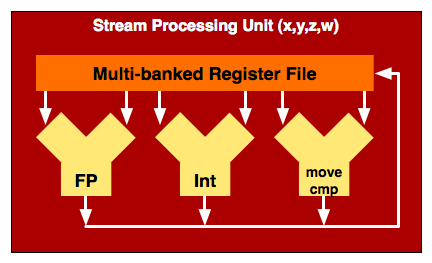
AMD's Stream Processing Unit is very similar to NVIDIA's SP in G80/G92/GT200, so similar in fact that I drew them the same way. Keep in mind that the actual inner workings of one of these units is far more complex than three ALUs but to keep things simple and consistent that's how I drew it (the actual hardware is a fused FP MUL + ADD unit, for those who care). AMD has four of these stream processing units in a processor block and they are called x, y, z or w units.
There's a fifth unit called a t-unit (the t stands for transcendental, meaning the type of operations it is capable of processing):

The t-unit can do everything a x,y,z or w-unit can do, but it also can do transcendental operations (represented by the SFU block in the diagram above). NVIDIA has the same functionality, it simply chooses to expose it in a different way (which we'll get to shortly). AMD considers each one of these units (x,y,z,w and t) a processing unit, and the RV770 has 800 of them (the RV670 had 320).
AMD pairs four of these stream processing units (x,y,z and w) with a t-unit and puts them together as a block, which I have decided to call a Streaming Processor (SP):

The area in red is actually the SP, but unlike one of NVIDIA's SPs, one of AMD's can handle up to five instructions at the same time. The only restriction here is that all five units have to be working on the same thread.
AMD then groups 16 of these SPs into something they like to call a SIMD core (AMD has less confusing, but far worse names for its architectural elements than NVIDIA):
|
AMD's SIMD Core
|
NVIDIA's SM
|
 |
 |
A SIMD core is very similar to NVIDIA's SM with a couple of exceptions:
1) There are more SPs in AMD's SIMD Core (16 vs 8)
2) The SPs are wider and can process, at peak, 5x the number of instructions as NVIDIA's SPs
3) The Instruction and Constant caches are not included in the SIMD core, AMD places them further up the ladder.
4) AMD pairs its texture units and texture cache with its SPs at the SIMD core level, while NVIDIA does it further up the ladder.
5) See the two SFUs in NVIDIA's SM? While NVIDIA has two very fast Special Function Units in its SM, AMD equips each SP with its own SFU. It's unclear which approach is actually faster given that we don't know the instruction latency or throughput of either SFU.
Note that at this point, the RV770 is really no different than the RV670 (the GPU used in the Radeon HD 3870). The next step is where AMD and NVIDIA really diverge; while NVIDIA's GT200 takes three SMs and groups them into a Texture/Processing Cluster (TPC) and then arranging 10 TPCs on its chip, AMD simply combines 10 SIMD cores:
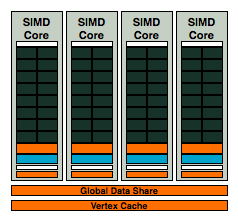
AMD's RV670
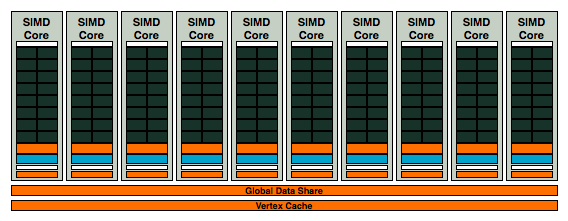
10 SIMD cores at your disposal in AMD's RV770, this is how AMD goes from competitive, to downright threatening
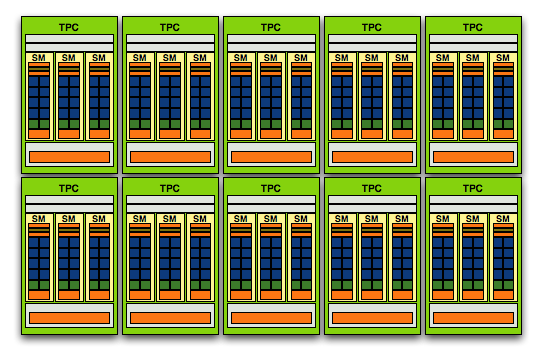
NVIDIA's GT200 Streaming Processor Array (SPA), it has fewer execution resources but more encapsulation around them, the focus here is on thread management
With 10 SIMD cores the RV770, it has 2.5x the number of execution units as a RV670. It even has more theoretical processing power than NVIDIA's GT200. If you just look at the number of concurrent instructions that can be processed on RV770 vs. GT200, the RV770's 800 execution units to GT200's 240 (+ 60 SFUs) is in a completely different league.
| NVIDIA GT200 | AMD RV770 | AMD RV670 | |
| SP Issue Width | 1-way | 5-way | 5-way |
| # of SPs | 240 | 160 | 64 |
| Worst Case Dependent Instruction Throughput | 240 | 160 | 64 |
| Maximum Scalar Instruction Throughput | 480* | 800 | 320 |
We'll be talking about efficiency and resource utilization in the coming pages, but immediately you'll notice that the RV770 (like the RV670 and R600 that came before it) has the potential to be slower than NVIDIA's architectures or significantly faster, depending entirely on how instruction or thread heavy the workload is. NVIDIA's architecture prefers tons of simple threads (one thread per SP) while AMD's architecture wants instruction heavy threads (since it can work on five instructions from a single thread at once).
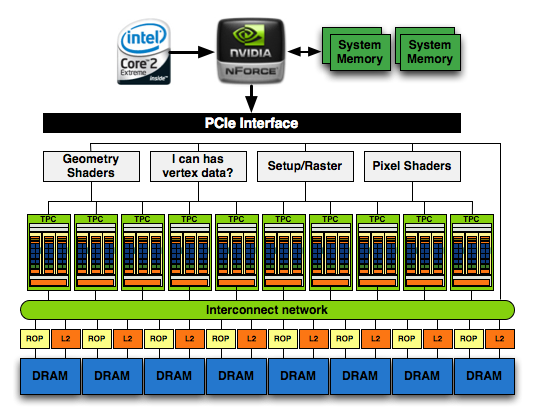
NVIDIA's GeForce GTX 280
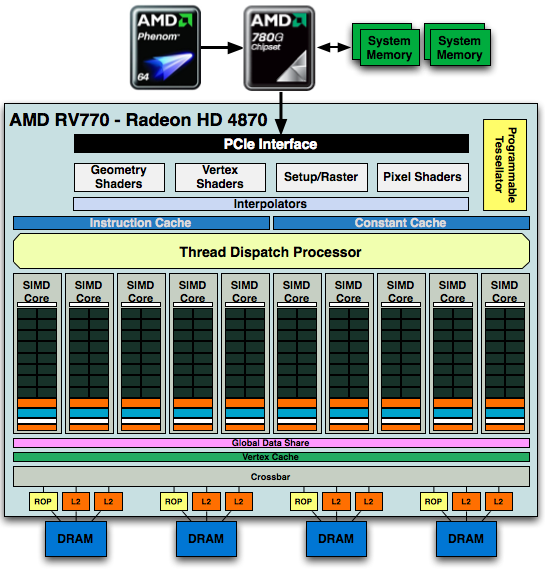
AMD's Radeon HD 4870
The full GPU is pretty impressive:
1) See the Instruction and Constant Caches up top? NVIDIA includes them in each SM while AMD seems to include them outside of the SIMD core clusters.
2) The RV770 only has four 64-bit memory controllers compared to the eight in GT200
3) The Programmable Tessellator is left over from the Xbox 360's GPU (and R600/RV670), unfortunately it is unused by most developers as there is no DirectX support for it yet.
4) AMD has dedicated hardware attribute interpolators, something NVIDIA's hardware shares with its special function units (SFUs).
Other than the differences we mentioned above, AMD's architecture is similar in vain to NVIDIA's, there are just a handful of design choices that set the two apart. Just like NVIDIA took its G80/G92 architecture and made it larger, AMD did the same with RV770 - it took RV670 and more than doubled its execution resources.
AMD took a bigger leap with RV770 from RV670 than NVIDIA did from G80/G92 to GT200, but it makes sense given that AMD had to be more competitive than it even was in the last generation.










215 Comments
View All Comments
DerekWilson - Wednesday, June 25, 2008 - link
it looks like the witcher hits an artificial 72fps barrier ... not sure why as we are running 60hz displays, but that's our best guess. vsync is disabled, so it is likely a software issue.JarredWalton - Wednesday, June 25, 2008 - link
Again, try faster CPUs to verify whether you are game limited or if there is a different bottleneck. The Witcher has a lot of stuff going on graphically that might limit frame rates to 70-75 FPS without a 4GHz Core 2 Duo/Quad chip.chizow - Wednesday, June 25, 2008 - link
It looks like there seems to be a lot of this going on in the high-end, with GT200, multi-GPU and even RV770 chips hitting FPS caps. In some titles, are you guys using Vsync? I saw Assassin's Creed was frame capped, is there a way to remove the cap like there is with UE3.0 games? It just seems like a lot of the results are very flat as you move across resolutions, even at higher resolutions like 16x10 and 19x12.Another thing I noticed was that multi-GPU seems to avoid some of this frame capping but the single-GPUs all still hit a wall around the same FPS.
Anyways, 4870 looks to be a great part, wondering if there will be a 1GB variant and if it will have any impact on performance.
DerekWilson - Wednesday, June 25, 2008 - link
the only test i know where the multi-gpu cards get past a frame limit is oblivion.we always run with vsync disabled in games.
we tend not to try forcing it off in the driver as interestingly that decrease performance in situations where it isn't needed.
we do force off where we can, but assassins creed is limiting the frame rate in absentia of vsync.
not sure about higher memory variants ... gddr5 is still pretty new, and density might not be high enough to hit that. The 4870 does have 16 memory chips on it for its 256-bit memory bus, so space might be an issue too ...
JarredWalton - Wednesday, June 25, 2008 - link
Um, Derek... http://www.anandtech.com/video/showdoc.aspx?i=3320...">I think you're CPU/platform limited in Assassin's Creed. You'll certainly need something faster than 3.2GHz to get much above 63FPS in my experience. Try overclocking to 4.0GHz and see what happens.weevil - Wednesday, June 25, 2008 - link
I didnt see the heat or noise benchmarks?gwynethgh - Wednesday, June 25, 2008 - link
No info from Anandtech on heat or noise. The info on the 4870 is most needed as most reviews indicate the 4850 with the single slot design/cooler runs very hot. Does the two slot design pay off in better cooling, is it quiet?DerekWilson - Wednesday, June 25, 2008 - link
a quick not really well controlled tests shows the 4850 and 4870 to be on par in terms of heat ... but i can't really go more into it right now.the thing is quiet under normal operation but it spins up to a fairly decent level at about 84 degrees. at full speed (which can be heard when the system powers up or under ungodly load and ambient heat conditions) it sounds insanely loud.
legoman666 - Wednesday, June 25, 2008 - link
I don't see the AA comparisons. There is no info on the heat or noise either.DerekWilson - Wednesday, June 25, 2008 - link
the aa comparison page had a problem with nested quotes in some cases in combination with some google ads on firefox (though it worked in safari ie and opera) ...this has been fixed ...
for heat and noise our commentary is up, but we don't have any quantitative data here ... we just had so much else to pack into the review that we didn't quite get testing done here.